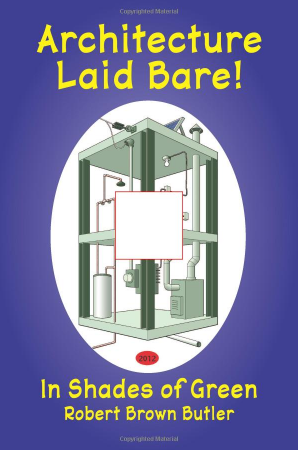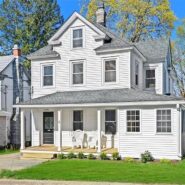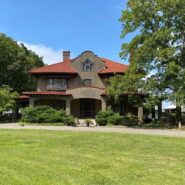What’s Better: Off-Grid or On?
Upstater | November 29, 2012 We’ve been leafing through this nifty book, Architecture Laid Bare, which offers some simple methods of eco-friendly home improvement, and we asked the author, Robert Brown Butler, to share some knowledge with you.
We’ve been leafing through this nifty book, Architecture Laid Bare, which offers some simple methods of eco-friendly home improvement, and we asked the author, Robert Brown Butler, to share some knowledge with you.
And here’s his offering: the plusses and minuses of living on the grid, or off.
So you’d like to live in the country? Whether you aspire to or are already there, in these modern times there is one amenity you likely won’t want to do without: Electricity. As you may know, this source of energy has a fork in it: one branch comes from “on-grid” generation, the other from “off-grid” generation.
On-grid generation of electricity is what your local utility power company produces. For the most part it is always available, and you can use as much of it as the circuit breakers in your panel box will allow. For this service you pay a certain amount, usually around 10 to 15 cents, for every kilowatt-hour you use. Now a kilowatt-hour is a thousand watts per hour. So if that light bulb hanging above you is a 50-watt bulb, if you burn it for 20 hours you will use one thousand watts, or one kilowatt, of electricity; and if you paid a dime for that kilowatt, it would cost you half a cent for every hour you used that 50-watt bulb. That doesn’t sound like much —but if you counted up every dime’s worth of electricity you used throughout your house every two months, you may pay a few hundred dollars every two months for your electricity, and possibly a few thousand dollars every year, ad infinitum.
On the other hand, off-grid generation is electricity you received not from a utility power plant miles away, but electricity produced right on your property, for which you pay virtually nothing for those electrons that flow through your breaker box. That means virtually no dollars every two months, and virtually no dollars every year, ad infinitum.
But in such ideal circumstances there is always a catch, isn’t there? The catch is this: No matter where those electrons come from, it costs a lot of money to install the machinery to produce them. With on-grid generation, the public utility has spent millions of dollars to supply sometimes millions of customers; and, being a profit-making business, they make each kilowatt for perhaps 15 percent less than what they sell it to you for. But they have one big problem with delivering this juice for your use: on average, they lose about two-thirds of the energy through the wires that transmit the electrons from their generators to your breaker box. So if they charge you, say, 12 cents for each kilowatt-hour you use, if you subtract 15 percent from that and divide the rest by one-third, you’ll find that the power company, on the average, produces the electricity you use for about 3.6 cents per kilowatt-hour.
Now theoretically, the physics of machines being the same everywhere, if they can do it you can do it: That is, if you knew how, you could install a generator on your property and pocket the 15 percent profit, avoid losing two-thirds of the rest, and even lower your production costs to nearly zero. That is the enticement of off-grid electricity.
But the other side of the coin is this: You have to know how. And that takes a lot of knowledge, a lot of initial expense, and a lot of time afterward to make sure everything keeps working properly. Let’s consider these three items one at a time:
A lot of knowledge … the plusses and minuses of this is that it takes a lot of time but costs little money. If you enjoy doing the former, this is the first sign that off-grid power generation may be a good idea on your property. There are other hurdles you must jump over, but being excited about this is the first. Considering the subject of this article we’ll assume this the case, and we will proceed to the next few hurdles you must jump over. These involve an objective analysis of your property’s potential to generate electricity. I know of no better description of this than pages 191–194 of my latest of seven books on architecture, Architecture Laid Bare!, which read as follows:
Using natural energy in a building does not begin with harnessing the heat of the sun, the force of the wind, or the weight of falling water. It begins with constructing thickly insulated building envelopes, creating maximum comfort in minimum volume indoors, and installing energy-efficient appliances. Only after you have minimized the energy you will need are you ready to go to all the labor and expense of satisfying those needs with natural energy. Then you should:
1. Analyze the site’s potential to harness natural energy. This begins —and often ends— by asking three questions:
i. Does the site receive a fairly high percentage of sunshine year round, especially in winter?
ii. Does wind blow strongly over the property?
iii. Does a stream of water descend a significant vertical distance on the property?
2. If the answer to one or more of the above questions is yes, the site may have the potential to harness natural energy. Next, list the occupancy’s critical electric load: the electrical uses that must be satisfied to make the occupancy habitable, such as running water, a few lights, and a refrigerator. If this load will include any appliances, use highly efficient ones. If firewood is available, consider installing an efficient fireplace or a woodstove with a flat cooktop and an insulated flue.
3. Determine the natural energy’s patterns of availability. On a site near Seattle the sun may shine an average 63 percent of the day in July but only 28 percent in January, when clouds and fog often obscure the sun when you need it most. And a creek in California may flow swiftly in March but be dry in September.
4. Will the system be off-grid or on-grid. In off-grid systems the building doesn’t have access to local electric power, then the system requires batteries to store its generated electricity for when more is needed than the system can provide. In on-grid systems the local utility provides electricity when more is needed than the system can supply, and when the system generates more than you need you can sell the excess back to the utility. Some won’t pay you nearly as much as you pay them while others will pay even more; so check. Batteries for off-grid systems typically add 20 to 40 percent to their cost and they require more maintenance; but off-grid properties often have notably lower land values which alone can make these systems economical. The most reliable system is on-grid with battery backup, but its dependability comes at a price.
5. Investigate incentive programs. Many governments and public utilities offer lower electric use rates, rebates, low-interest loans, cash subsidies, tax credits, property tax exemptions, permit fee reductions, and other incentives for natural energy systems that will serve residences and small businesses. These financial reductions can tip the scales of feasibility from negative to positive.
6. A presently little-considered aspect of producing electricity from natural energy is that each system supplies electricity for only one building or, as with the huge windmills being built today, hundreds of buildings. There is virtually nothing in between, while in many places a stream, hilltop, or large field could satisfy the energy demands of several neighboring houses. Then a system that would supply, say, six families might cost only three times more than a system for one.
Only now are you ready to analyze the site’s potential to harness solar, wind, or water energy, as detailed below.
At this point, I regret to say that we have nearly run out of space. But once you’ve jumped over the above hurdles, you can pretty much clear the rest on your own. My book does have 15 more pages on the logistics involved, but eventually you’ll have to find local businesses who have experience in installing these systems and then discuss in great detail the nature, installation, and maintenance of every last nut and bolt of the most feasible system for your property. My purpose here has been twofold: (1) not to woo you to these systems’ use but to wisen you to their nature, and (2) to the extent that you are interested to get you logistically headed in the most sensible direction. But before we sign off I will give you a few pointers on the other two items mentioned above:
A lot of initial expense … When discussing these systems with prospective installers, pay close attention to how much you will pay initially to how much you will save later on. A good guide is the cost-benefit ratio, which is the amount of initial cost compared to annual savings realized over a number of years. For example, if you spend $30,000 for a system that will save you $900 a year, you will save 600/30,000 = 3 percent of your initial investment per year. No deception there. But what if you invest the same $30,000 in interest-bearing stocks and bonds that will yield an annual dividend of 4 percent? You would save $1200 every year with likely less trouble. Of course the only sure tool for making such adept comparisons is a crystal ball. Still, whether you can predict the future or not, only if a renewable energy system’s annual savings compared to its original cost will “beat” the going interest rate will it be worth investing in over the long haul. However, there are other “variable interest rates” at work here: our governments’ varying interests in conserving energy, which can lead congresses and legislatures to offer rebates and tax credits during one administration and revoke them during another. Lately most of our governments are strongly encouraging the use of natural energy systems and offer the incentives to prove it —but in every case, you should gather all the facts and meticulously run the numbers to be as sure as you feasibly can that you will come out ahead over the long haul.
A lot of time afterward … If you decide to generate your electricity with these systems, one realization you will have to confront is they will take a lot of time to maintain. Depending on your psychological propensities and mechanical inclinations, this can be either a joy or a burden. This is the final hurdle you’ll need to clear. Certainly it is think to know about this not at the end but before you start.
However, if you do end up saving money with these systems and enjoying the work it takes to save it, you’ll find another treasure at the end of this rainbow: the freedom of knowing your destiny is not determined by events beyond your horizons whose control is out of your grasp.
Read On, Reader...
-

Jane Anderson | April 26, 2024 | Comment The C.1738 Meeting House in Palisades: $1.895M
-

Jane Anderson | April 25, 2024 | Comment The Jan Pier Residence in Rhinebeck: $1.25M
-

Jane Anderson | April 24, 2024 | Comment A C.1845 Two-Story in the Heart of Warwick: $524K
-

Jane Anderson | April 23, 2024 | Comment A Gothic Home in Hudson: $799.9K
